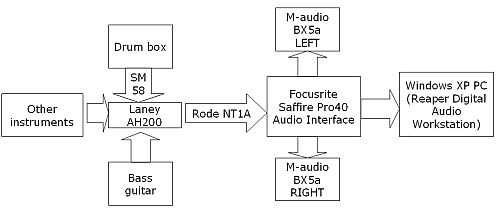This post illustrates a method on how you can record a cajon or acoustic drum box. To further illustrate the complexity; consider an acoustic live band scenario where the cajon is recorded together with other musical instruments such as a bass guitar.
The recording can be challenging if the aim is to capture the natural punch and sound of the drum box to your DAW.
Gears/Equipments Used in this Setup
In this setup the following gears and equipments are used:
1.) Focusrite Saffire Pro40 audio interface
2.) Rode NT1A condenser microphone for micing the Laney amplifier
3.) Laney AH200 amplifier
4.) SM58 dynamic microphone for micing the cajon drum box.
5.) Reaper DAW in Windows XP PC
6.) M-audio BX5a reference monitor
7.) Two musical instruments- one bass guitar and one cajon acoustic drum box
The signal flow of the recording is as follows:

One important technique here for sound quality is to use a power amplifier which will handle all incoming music instrument level signals. These signals are then feed to the Saffire Pro40 audio interface via the condenser microphone. For example in the above screenshot; the power amplifier used is Laney AH200. This amplifier can also handle all types of signals whether coming from a bass guitar, acoustic/electric guitar, keyboards, drum box, vocals, etc. The good thing is that most live venues do include a power amplifier cabinet.
Also one big advantage is that you can apply individual EQ and effects for each music instrument with Laney AH200. In this setup, you won’t need a hardware mixer in your home for the live recording. On the other hand; Laney AH200 can accept up to six individual music instruments in the line input.
Micing the Cajon
SM58 dynamic microphone is used to capture the natural sound of the cajon acoustic drum box. Some drum box does include a line out circuitry which will be feed to an amplifier or something. But I do not recommend using this for recording because it cannot capture the natural sound of the cajon drum box.
The recommended approach is to put the microphone (SM 58 in this example) directly at the hole of the cajon drum box such as shown below:

Do not place the microphone inside the hole because it cannot capture the ambiance and natural reverberations of the room. In addition, placing it very far from the hole can decrease the punch of the bass drum sound.









No responses yet